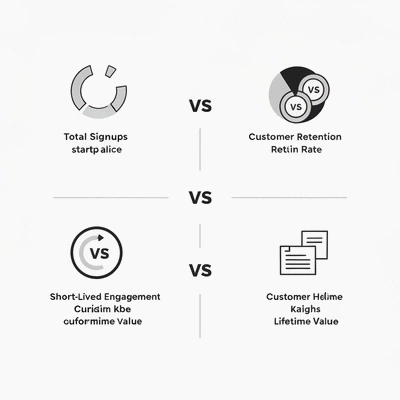Did you know that focusing solely on the number of initial customers can lead to misguided strategies? It's time to rethink what truly drives startup success.
What You Will Learn
- Early customer numbers can be deceptive and often represent vanity metrics rather than sustainable success.
- Customer retention is more important than initial acquisition; loyal customers drive long-term growth.
- Understanding the difference between engagement metrics and mere signups is crucial for accurate performance assessment.
- Effective customer acquisition strategies should focus on targeted marketing and clear value propositions.
- Utilizing customer feedback can significantly enhance product offerings and improve overall satisfaction.
- Prioritizing meaningful metrics like Customer Lifetime Value (LTV) provides a clearer picture of your startup's health.
Prioritizing Metrics for Startup Success
Focusing on key performance indicators rather than vanity metrics is crucial for sustainable growth. See below for a comparison of misleading metrics versus truly indicative ones.
Misleading Metrics (Vanity Metrics)
- ‣ Total Signups / Downloads
- ‣ Short-Lived Engagement
- ‣ High Initial Acquisition
Key Performance Indicators (KPIs)
- ‣ Customer Retention Rate
- ‣ Customer Lifetime Value (LTV)
- ‣ Customer Acquisition Cost (CAC)
Essential Tools for Tracking Metrics
- ‣ Google Analytics
- ‣ Mixpanel
- ‣ HubSpot
- ‣ Feedback Tools (e.g., SurveyMonkey)
Leveraging Customer Feedback
- ‣ Conduct Surveys
- ‣ Monitor Reviews
- ‣ Engage on Social Media
- ‣ Implement Feedback Loops
Understanding the Myth of the First 100 Customers
Getting your first 100 customers is often celebrated in the startup world. But let’s pause for a moment and consider the implications of this milestone. While it may feel like a huge achievement, these numbers can be quite deceptive. In reality, early customer numbers can sometimes represent what I like to call 'vanity metrics'—numbers that look good on paper but don’t necessarily reflect the health or sustainability of your startup.
For instance, a startup might launch with a flashy marketing campaign that brings in a flood of signups, but if most of those customers churn within a month, what does that really say? It's essential to dig deeper rather than just celebrating the surface-level success. We need to explore why these early numbers might not be the best indicator of future success.
Why Early Customer Numbers Can Be Misleading
Early customer numbers can lead to an inflated sense of security. Many founders fall into the trap of believing that the sheer volume of customers equates to success. However, focusing solely on these metrics can distract from critical aspects of the business, like customer satisfaction and product-market fit.
- Vanity Metrics: These might include the total number of signups or downloads, which can be misleading without context.
- Short-Lived Engagement: New customers can easily be enticed by promotions but may not stay loyal post-promotion.
- Quality Over Quantity: Having a few loyal customers who advocate for your brand is often far more valuable than a large number of disengaged users.

Instead of celebrating numbers without context, startups should focus on actions that foster genuine engagement. This approach shifts the focus from merely acquiring customers to building a lasting relationship with them.
The Importance of Customer Retention Over Initial Count
At The Stone Builders Rejected, we believe that customer retention should be the primary metric to monitor as it directly correlates with long-term success. It’s not just about how many customers you attract initially, but rather how well you keep them engaged and satisfied over time.
- Retention Rate: This indicates the percentage of customers who continue to use your product or service after their initial experience.
- Engagement Metrics: Understanding how often customers interact with your product can provide insights into their satisfaction.
- Feedback Loops: Regularly collecting feedback helps you improve your offerings and retain customers more effectively.
Focusing on retention leads to sustainable growth. When customers are happy with your product, they’re not just more likely to stick around; they may also share their positive experiences with others, effectively becoming your best marketing tool!
Exploring the Role of Customer Acquisition in Startup Success
While retention is critical, the process of customer acquisition cannot be overlooked. This is where effective strategies come into play, shaping how you interact with potential customers and ultimately driving your startup's growth. Without a solid acquisition strategy, even the best product can struggle to gain traction.
To acquire your first customers, consider various approaches. The Small Business Administration (SBA) suggests several strategies, including leveraging your network, offering incentives, and utilizing digital marketing. These methods can help you effectively identify and attract your target audience.
- Targeted Marketing: Identify your ideal customers and tailor your message to resonate with them.
- Channel Optimization: Utilize various channels—social media, email marketing, and partnerships—to reach your audience effectively.
- Value Proposition: Clearly communicate what sets your product apart and why customers should choose you over the competition.
When done right, customer acquisition strategies not only help you build your initial customer base but also lay the groundwork for a robust retention strategy down the line. Remember, every successful startup begins with the right blend of acquisition and retention tactics.
Essential Metrics That Indicate Startup Success
Understanding what metrics truly matter can make all the difference in your startup journey. Rather than getting hung up on vanity metrics, it's crucial to focus on data that reflects actual performance and growth. The Federal Reserve's reports on startup firms often highlight the importance of sustainable growth patterns, emphasizing that true success lies beyond mere initial customer counts.
Pro Tip
To ensure sustainable growth, focus on nurturing relationships with your customers instead of just numbers. Implement customer feedback loops and engage with your audience regularly to understand their needs and improve your offerings. This approach not only enhances customer satisfaction but also fosters loyalty, ultimately leading to a stronger foundation for your startup.
Frequently Asked Questions (FAQs)
Concluding Insights on Startup Metrics
As we wrap up our exploration of startup metrics, it's clear that rethinking your focus is vital for success. Instead of getting caught up in the allure of early customer counts, it's crucial to prioritize metrics that truly reflect your business's health. Understanding the difference between vanity metrics and key performance indicators will help you make more informed decisions as you move forward. When looking to perform market research and competitive analysis, the SBA provides valuable resources that can further refine your understanding of your market position.
By shifting your focus to meaningful metrics, you'll be better positioned to analyze customer satisfaction and long-term growth potential. Metrics like Customer Lifetime Value (LTV) and retention rates provide a clearer picture of how well your startup is performing and where you need to improve.
Taking Action: Tools and Resources for Startup Health Checks
To effectively assess your startup’s metrics, leveraging the right tools and resources is essential. Here are some recommended tools you might consider:
- Google Analytics: Great for tracking website engagement and user behavior.
- Mixpanel: Allows you to analyze user interactions and retention.
- HubSpot: Offers a wide range of marketing and sales tools, including analytics.
- Customer Feedback Tools: Tools like SurveyMonkey or Typeform help gather valuable customer insights.

These tools make it easier to track key metrics like Customer Acquisition Cost (CAC) and retention rates. By actively using these resources, you're more likely to identify areas for improvement and growth.
Leveraging Customer Feedback for Continuous Improvement
One of the most effective ways to enhance your startup's performance is through customer feedback. Regularly seeking feedback can provide insights that are invaluable for refining your business model. Here’s how to effectively leverage it:
- Conduct Surveys: Use short, focused surveys to gather specific insights on customer experience.
- Monitor Reviews: Keep an eye on online reviews to understand customer sentiment.
- Engage on Social Media: Use social platforms to interact with customers and learn about their needs.
- Implement Feedback Loops: Create systems to incorporate customer suggestions into your products or services.
By listening to your customers and implementing changes based on their feedback, you not only improve their experience but also enhance your overall startup health. This continuous improvement cycle is vital for long-term sustainability and growth.
Final Thoughts on Your First 100 Customers and Beyond
Building a Sustainable Growth Strategy
As I reflect on the journey of startups, it’s evident that building a sustainable growth strategy is about more than just acquiring customers. It’s about fostering relationships that lead to long-term engagement and loyalty. Embrace a mindset that prioritizes retention and customer satisfaction, and you'll set yourself up for success.
Remember, it’s not just about those first 100 customers; it’s about retaining them and turning them into brand advocates. When you nurture your customer base, your startup stands a better chance of thriving in today’s competitive landscape.
Engage with Us for Further Insights
We’d love to hear from you! What metrics have you found most valuable in your journey? Share your experiences and insights in the comments below. If you're looking for more resources or want to discuss your startup metrics further, don’t hesitate to reach out to us at The Stone Builders Rejected. Let's keep the conversation going and support each other on this exciting path of entrepreneurship!
Recap of Key Points
Here is a quick recap of the important points discussed in the article:
- Avoid Vanity Metrics: Focus on meaningful metrics beyond just the number of customers.
- Prioritize Customer Retention: Retention rates are more indicative of long-term success than initial customer counts.
- Engagement Matters: Build genuine relationships with customers to foster loyalty and advocacy.
- Effective Acquisition Strategies: Targeted marketing and clear value propositions are key to attracting the right customers.
- Leverage Customer Feedback: Regular feedback collection is essential for continuous improvement and customer satisfaction.






